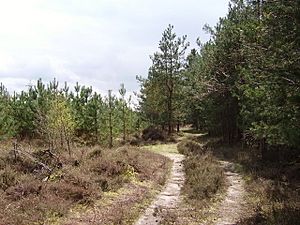Bramshill SSSI facts for kids
| Site of Special Scientific Interest | |
 |
|
| Area of Search | Hampshire |
|---|---|
| Interest | Biological |
| Area | 673.3 hectares (1,664 acres) |
| Notification | 2000 |
| Location map | Magic Map |
Bramshill is a special natural area in Hampshire, England. It covers about 673 hectares, which is like 1,663 football fields! This site is officially known as a Site of Special Scientific Interest (SSSI).
An SSSI is a place that has important plants, animals, or geology. Bramshill is important for its biology, meaning its living things. It's also part of a bigger area called the Thames Basin Heaths Special Protection Area. This larger area helps protect wild birds.
What Makes Bramshill Special?
Bramshill is a mix of different natural habitats. These include forests, wetlands, and open grassy areas. Each part provides a home for unique creatures.
Amazing Wildlife
The forests at Bramshill are mostly made up of conifer trees. These trees are very important for certain birds. You can find large groups of woodlarks, nightjars, and Dartford warblers here. These birds are important on a global scale.
- Woodlarks: These small brown birds are known for their beautiful songs. They often sing while flying high in the sky.
- Nightjars: These birds are masters of camouflage. They are active at night, hunting insects.
- Dartford Warblers: These tiny birds are usually found in heathland areas. They are quite rare in many parts of the UK.
Wonderful Wetlands
Bramshill also has several pools and wet, boggy areas called mires. These watery places are perfect for insects. They are home to many different kinds of dragonflies and damselflies. Watching these colorful insects dart around is a real treat.
Rare Plants
Beyond the forests and wetlands, there's a special meadow at Bramshill. This meadow has not been changed by farming or building. It provides a home for a very rare flowering plant called small fleabane. This plant is nationally rare, meaning it's hard to find anywhere else in the country.

